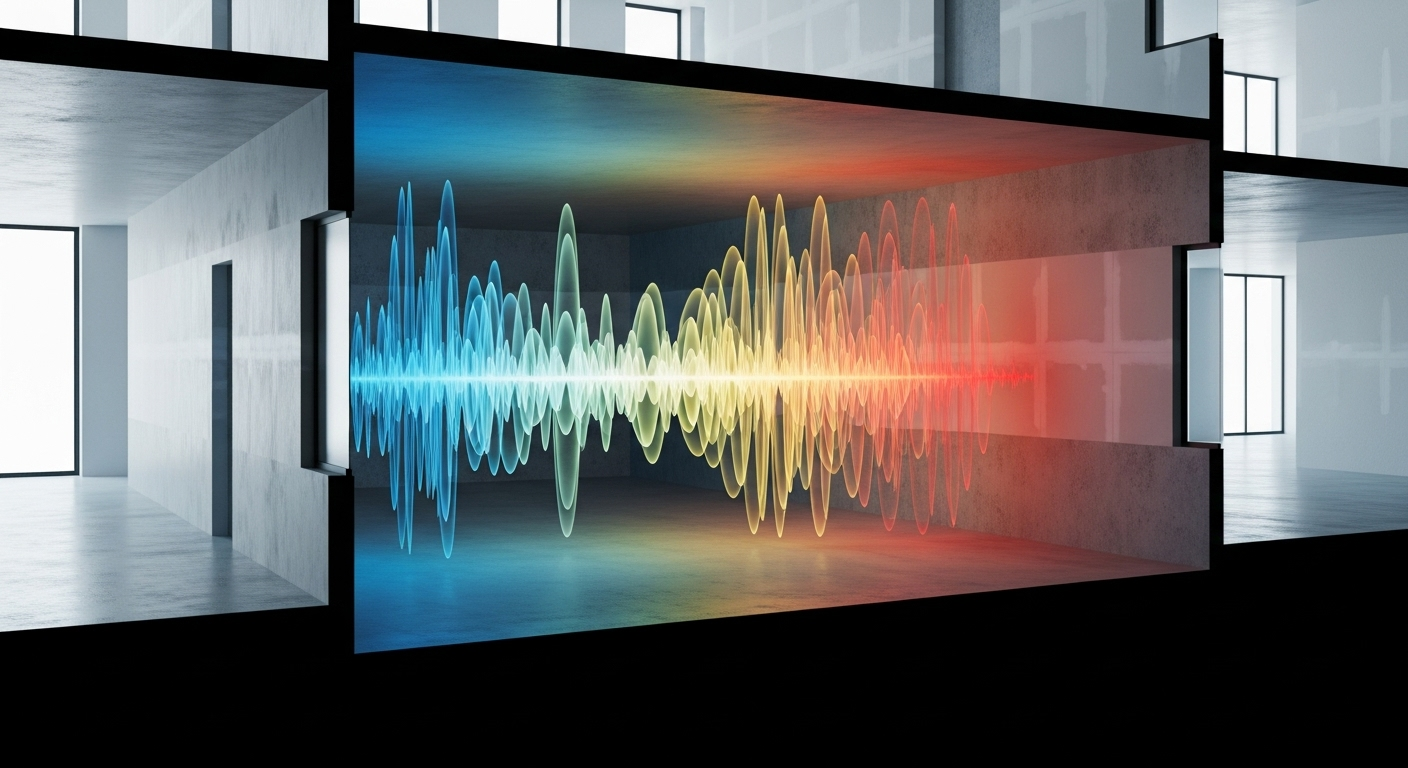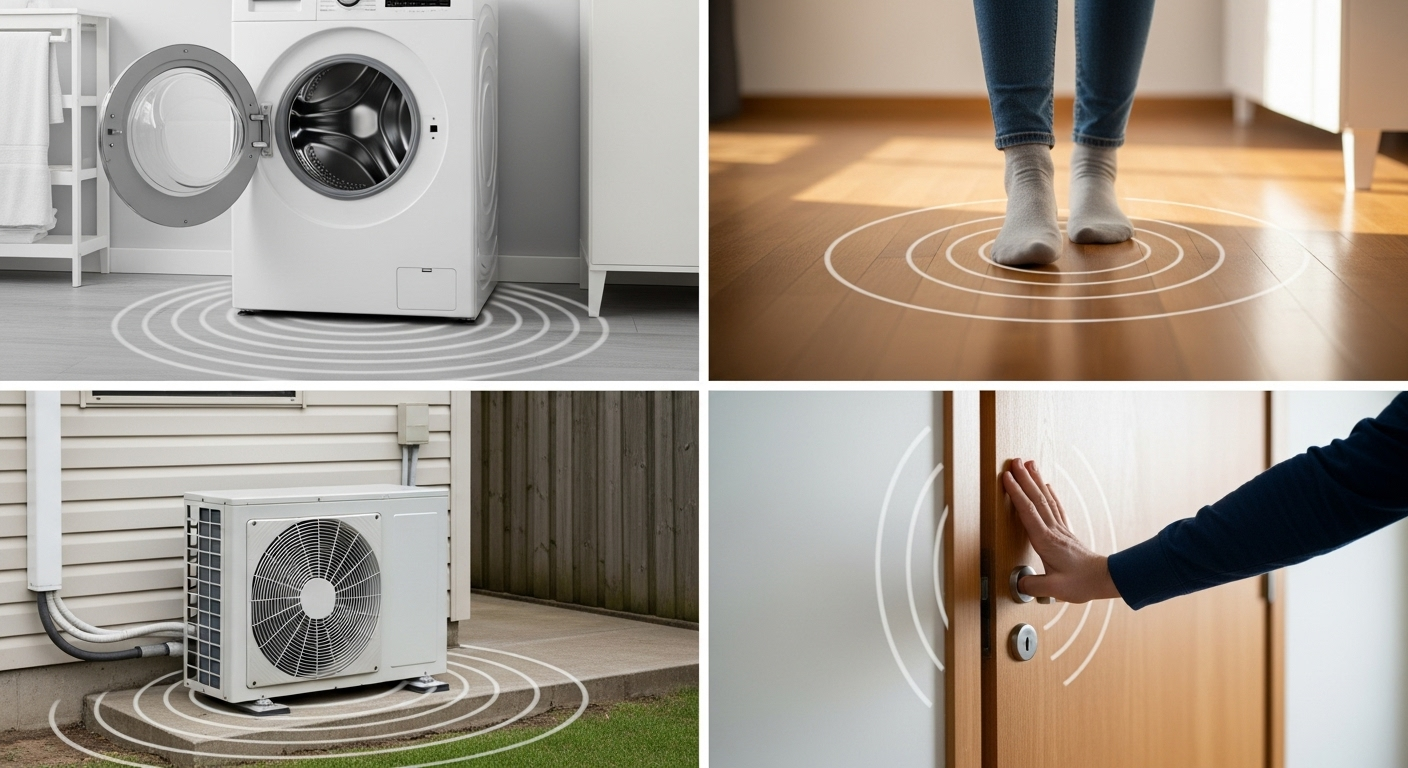
When you think about noise, you probably picture sounds traveling through the air — voices, music, or traffic outside. But what most people don’t realize is that much of the noise in homes, offices, and buildings doesn’t just float through the air. It moves through solid materials. This type of noise is called structure-borne sound, and it’s one of the most overlooked problems in soundproofing.
At Sound Pro Solutions, we specialize in identifying and controlling both airborne and structure-borne sound. Understanding how sound behaves inside walls, floors, and ceilings helps you design spaces that actually stay quiet — not just look like they should be.
Structure-Borne Sound Definition and Why It Matters
So, what exactly is structure-borne sound? In simple terms, it’s noise that travels through solid materials rather than air. When something vibrates — like footsteps on a wooden floor or a washing machine spinning in the next room — those vibrations spread through the building’s structure. The sound doesn’t need air to move; it uses the walls, floors, and beams as its highway.
This is why you might hear your upstairs neighbor walking even though the ceiling between you is sealed tight. The energy from their steps transfers through the structure, becoming audible again when it reaches your space.
Understanding this structure-borne sound definition matters because traditional soundproofing methods often target airborne noise only. Foam panels, curtains, and acoustic tiles do little against vibration-driven sound. If you want true quiet, you have to treat both.
How Structure-Borne Sound Travels Through Buildings
Imagine tapping your desk with your knuckle. The sound you hear isn’t just what reaches your ears through the air — it’s also what vibrates through the desk surface. Buildings work the same way. Every impact, bump, or machine vibration sends ripples of energy through the structure.
These vibrations can travel surprisingly far. A noisy HVAC unit in the basement can cause a hum on the top floor. A door slamming in one room can make a wall rattle two rooms away. That’s structure-borne sound transmission in action — invisible but powerful.
The biggest challenge is that once sound enters the structure, it spreads easily. Walls and floors act like massive amplifiers, carrying low-frequency energy across large distances. This is why even small sources, like a refrigerator compressor, can create background noise throughout a home.
Airborne and Structure-Borne Sound Compared
When diagnosing a noise problem, one of the first things we do at Sound Pro Solutions is determine what type of sound we’re dealing with: airborne or structure-borne. These two behave very differently, which means your solution must match the source.
Airborne noise is exactly what it sounds like — sound waves that travel through air. Speech, television, and music are typical examples. You can block them with dense barriers, acoustic panels, or insulation.
Structure-borne noise is trickier. It starts as a physical vibration, which means it doesn’t care how thick your wall is. It transfers through screws, studs, joists, and even pipes. You can think of it as mechanical energy that needs to be isolated, not absorbed.
That’s why combining airborne and structure-borne sound treatments is so important. You can have the best foam or insulation, but if your walls are still vibrating, you’ll still hear the noise.
Key Differences That Change Your Soundproofing Strategy
The main difference between these two types of noise is how they move — and therefore how you fight them. Airborne noise is blocked by mass. Structure-borne noise is stopped by isolation.
If your neighbor’s voice is coming through the wall, that’s airborne noise. Add more mass or dense insulation. But if you hear low rumbles when they walk or drop something, that’s vibration — and no amount of foam will fix it.
This is where vibration and structure-borne sound dampers become essential. They act as shock absorbers within your structure. Instead of letting sound energy move freely, they convert it into harmless heat or redirect it into materials that don’t resonate.
The result? A significant reduction in impact noise and vibration transfer — not just a quieter room, but a calmer one.
Why Structure-Borne Sound Is Harder to Block
Stopping airborne noise is often straightforward — add insulation, seal gaps, or install denser walls. But structure-borne noise? That’s a whole different story. The reason it’s so stubborn is simple: it moves through the structure itself.
When something vibrates — a subwoofer, a washing machine, or even footsteps — the energy passes into solid materials, turning your entire building into a massive resonator. Once those vibrations start traveling through concrete or wood, they don’t stop easily. This is why structure-borne sound transmission is considered one of the hardest acoustic challenges to solve.
Even small sources can create big problems. A door that slams repeatedly, for example, can send vibrations through studs and drywall, making nearby walls hum. You might treat the walls for airborne noise and still hear that dull thump. That’s the beauty — and frustration — of structure-borne sound. It’s invisible, relentless, and requires precise treatment rather than guesswork.
How Both Types Work Together to Create Noise Problems
In the real world, noise isn’t usually just one thing. Airborne and structure-borne sound often work together, creating a mix of vibration and echo that spreads throughout a building.
Take a washing machine, for instance. The motor creates structure-borne sound through the floor, while the spinning drum produces airborne noise in the air around it. That’s why even after adding foam or insulation, you can still hear a faint hum — because the vibration is traveling under your feet.
The same happens in offices, apartment buildings, and recording studios. A single sound source can generate multiple pathways of transmission. That’s why an effective soundproofing plan must address both — blocking the air path and damping the vibration path. Ignoring either side means leaving part of the problem unsolved.
At Sound Pro Solutions, we always start with an acoustic assessment to identify these dual pathways. It’s not guesswork — it’s science. And it’s how we achieve the kind of quiet most people didn’t think was possible.
Structure-Borne Sound Examples You Deal With Every Day

You might think structure-borne noise only happens in factories or construction zones, but you deal with it constantly. Here are some structure-borne sound examples you’ve probably noticed without realizing it:
- Footsteps from the floor above you.
- A door slamming and echoing through the hallway.
- The rumble of an air conditioner or HVAC system.
- A washing machine’s spin cycle shakes the wall.
- Vibrations from nearby elevators or plumbing pipes.
- A subwoofer is making your coffee table buzz.
All of these sounds have one thing in common — vibration energy moving through solid material. The more rigid the material, the farther the sound travels.
That’s why homes with hardwood floors, exposed beams, or metal ducts often carry more noise than those with soft surfaces. If your walls or floors ever feel like they “hum” when sound is present, that’s a classic case of structure-borne sound in action.
The Problem with Traditional Soundproofing for Structure-Borne Sound
Most traditional soundproofing materials — foam panels, acoustic curtains, fabric diffusers — work great for airborne sound. They absorb or scatter sound waves moving through the air. But they don’t stop vibration.
You could cover your walls with the thickest foam available and still hear that deep rumble from next door. Why? Because vibration doesn’t care about foam. It passes through studs, joists, and even concrete floors. The only way to stop it is by breaking the connection between materials.
This is where structure-borne sound dampers come in. They isolate surfaces so vibrations can’t jump from one area to another. For example, rubber isolation pads under a washing machine or resilient clips behind drywall act like shock absorbers, absorbing energy before it spreads.
Ignoring this step is one of the most common mistakes in DIY soundproofing. People focus entirely on sound absorption and forget about vibration control. But in reality, structure-borne isolation is the foundation of true acoustic comfort.
Complete Structure-Borne Sound Solutions We Recommend
At Sound Pro Solutions, we’ve tested hundreds of materials and configurations over the years. The most effective approach to structure-borne noise always combines vibration and structure-borne sound dampers with targeted insulation and decoupling methods.
Here’s what we typically recommend for residential and commercial spaces:
- Resilient channels and isolation clips - These separate drywall from studs, creating a flexible barrier that prevents vibration transfer.
- Rubber or neoprene pads - Ideal under appliances, HVAC units, or machinery to absorb impact vibrations.
- Acoustic underlayment - A dense, flexible layer beneath flooring that stops impact noise from traveling through the floor structure.
- Mass-loaded vinyl (MLV) - Adds mass and damping to walls, floors, or ceilings without major construction.
- Rockwool insulation - Fills wall cavities to absorb both airborne and low-frequency structural noise.
When used together, these tools target every stage of structure-borne sound transmission — from the vibration source to the resonating surfaces.
And the best part? You don’t have to figure it out alone. Our team at Sound Pro Solutions helps clients choose the right combination for their unique setup, ensuring professional-level results at home or in commercial environments.
We ship nationwide with fast delivery, and our return policy is simple — if a product doesn’t perform as promised, we’ll make it right. That’s how we’ve built long-term trust in the soundproofing industry.
True quiet isn’t about luck — it’s about science, precision, and the right materials. Explore our range of structure-borne sound dampers and insulation systems at soundprosolutions.com and experience the difference a professionally sound-treated space can make.
Recent posts




